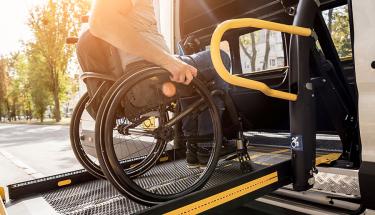Context
The Board is committed to supporting the full and equal participation of people with disabilities, as well as continuing to work towards inclusivity and accessibility in the passenger transportation industry.
The Board is focused on supporting an increase in the number of passenger transportation vehicles that provide accessibility to people in wheelchairs and for those who use mobility aids. The Board supports having wheelchair accessible taxis integrated with taxi fleets in communities across British Columbia.
Taxis have a duty to serve the general public, including people with disabilities and those who use wheelchairs or other mobility aids. The Board has an ongoing priority to integrate wheelchair accessible vehicles into taxi fleets across B.C. Requirements related to the provision of wheelchair accessible vehicles (WAVs) are typically included in the terms and conditions of licence for taxis.
Although other passenger transportation services may not be required by the terms and conditions of the licence to provide dedicated WAVs, they must comply with all other applicable laws on this issue. Also, they are subject to requirements intended to promote accessibility. For example, Transportation Network Services (or ride-hailing), which typically rely on drivers using their own personal vehicles, are required under the Regulations, to pay a fee for each trip provided in a non-WAV. The per trip fee is administered by the Ministry of Transportation and Infrastructure and the funds are used to support programs such as the Passenger Transportation Accessibility Program (PTAP).
Applicability
The policy applies to:
- Applications
- Taxi Licensees
- Specialty Vehicles
Policy
Accessible service plan
Applicants are expected to include information about accessible services they provide and alternatives that are available in their community.
Except for operators in small communities (under 10,000 population), applicants seeking additional taxis are required to give the Board an Accessible Service Plan. The Board may require a minimum number of the additional taxis to be WAVs.
Taxi operators must submit an accessible service plan when:
- Starting a new taxi service and wanting to use wheelchair accessible taxis.
- Adding taxis to a fleet, whether the fleet has wheelchair accessible taxis or not.
Taxi operators serving communities with less than 10,000 people do not need to submit an accessible service plan.
Considerations
When an applicant proposes to increase the number of taxis in their fleet, the Board looks to evidence supplied by the applicant to show the level of public need for all types of taxi services in the area. Accessibility is a public need factor.
The Board may consider the need for both conventional and accessible services, whether an applicant seeks to add WAV to their fleet or not.
When making decisions about WAVs, the Board may consider the following:
- The characteristics of the community.
- Matters such as age and population demographics.
- The total number of conventional and WAV in the community.
- Proximity of the community to other transportation modes.
When the Board approves an application for a new taxi service, or to add vehicles to an existing taxi fleet, it may approve or set terms and conditions that establish requirements regarding the operation of WAVs and the minimum required number of WAVs to be included within the approved maximum fleet allotment.
Vehicle requirements
Any WAV approved by the Board must meet vehicle standards set out in Division 44 (Accessible Taxis), Motor Vehicle Act Regulations.
Dual use
WAVs are considered dual use. This means they may carry passengers whether a passenger has a wheelchair, scooter, or other mobility device, or not. Licensees may, on their own initiative, operate any number of the taxis in their fleet as WAVs.
Some licensees have express authorization to install flip seats in their WAV. This has the benefit of:
- Increasing vehicle capacity to carry more passengers and more luggage.
- Giving drivers sources of revenue that are not available to drivers of smaller, conventional taxis.
- Helping to offset the higher costs of operating a WAV.
Priority dispatch
When the Board requires WAVs, it will typically specify as a term and condition of licence that WAVs are dispatched on a priority basis to persons with wheelchair or mobility aids who require accessible transportation. WAVs that a taxi licensee operates should be managed and dispatched on a priority basis, so that the transportation needs of people with disabilities are adequately met.
Rates
The Board makes no distinction between WAV fleet and conventional taxi fleet when establishing rates.
Legislation
Passenger Transporation Act:
28 (3) The board may establish terms and conditions that apply to a special authorization included in a licence, if issued, including, without limitation, terms and conditions respecting any of the following:
(a) equipment or technology that must be installed, used or carried on or in motor vehicles operated under the authorization and the inspection, testing, adjustment, display and use of that equipment or technology…
